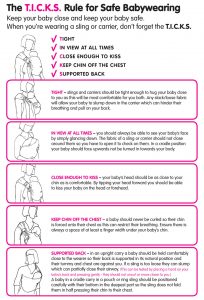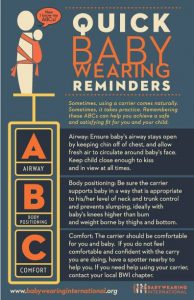Every parent or carer wants to know that their baby or child is safe, so how can we do this in a sling?
There are various guidelines available, such as the TICKS and ABCs (listed below), but I have my own. Very simply:
Breathing and Falling.
Falling
First of all – we need to know our baby is secure and will not fall.
This generally means making sure the sling or carrier is tight enough and covering their body – in a baby under a year we want the carrier to reach the bottom of the head/top of the neck and in a child over a year we want them supported up to armpit level. We also want to think about baby’s feet. Even young babies will push with their feet (indeed they have a step reflex which makes them do this) and babies can be very strong – so we need to make sure they cannot push themselves up out of the carrier with their feet.
If you are concerned that your baby is not secure, and for example need to hold or support your baby while they are in the sling to prevent them falling then the sling is NOT doing its job as a hands free carrier. (You may decide that you will use it as a carrying aid at that time and not adjust. That is fine as long as you are keeping your baby safe by keeping hands on them. But if you wish to be hands free you must ensure your baby is safe and supported, so in this case adjust or retie the carrier).
The majority of falls occur while children are being put in, removed from or moving position (for example from front to back) in a carrier. So be very aware of your child’s safety during these times, keeping a hand on your child until you are certain they are secure – if in doubt hold on! It can be useful to practice with a doll or teddy bear, and to try things out near soft surfaces – over a bed or sofa the first few times.
Breathing
Your baby needs to breathe!! This means that their airway is clear and their position and temperature does not compromise their breathing.
Once the baby is secure and not at risk of falling we need to make certain there is no fabric or anything else on their face which could suffocate them. I recommend your baby is positioned high on your chest with their arms up and in front of them. No fabric from a wrap, or bulky fabric from your clothes should be allowed to cover their face. Breasts are also something to be aware of, and again positioning baby so their face is above breast tissue will reduce this risk.
Babies with poor head control (particularly newborns) are at risk of positional asphyxia. This occurs when the chin falls onto the chest, causing a kink in the windpipe and reducced oxygen flow. This is a risk for all babies but those who are already phone to breathing issues (those who were premature or who have apnoea) are especially vulnerable. Therefore making sure baby is supported in a position where their chin is off their chest and in which they will not slump is vital. Again the tightness of the carrier can be important – too loose and baby is more likely to be low and/or slumped.
Temperature is also important. When babies get too hot their breathing slows. Again this is a risk for all, but some babies are especially vulnerable. For this reason it is important not to overdress babies in the sling; dress them in light layers, and on cold days add extra layers on top of the sling or carrier which can be removed when you are indoors. While babywearing coats are available there are also panels that can be added to existing coats, covers for carriers, very simple measures such as wearing a large coat or tucking a cot blanket over and around the sling will also do the trick for minimum expense.
Other Safety Concerns
Temperature: I have already mentioned the need to keep babies cool enough because a baby that is too hot may not breathe as well as it should. But keeping baby warm enough is also important. Luckily in the UK this is not a major concern for most of the year, but if you live outside the UK, are travelling somewhere unusually cold or we are in one of our rare cold snaps then baby’s temperature is also important. When trying to assess your baby it is not helpful to feel hands and feet as they often feel cold, but their chest or back. As mentioned above, layer up, and use things like hats, gloves and booties to keep extremities warm. Remember to remove extra layers when you enter warmer places.
Tripping or Falling: Trips and falls are a concern for many parents, especially those who are new to sling use; and it is something to consider. There are things you can do to avoid trips and falls – sensible footwear, awareness of weather etc. It is a judgement call for parents. Common sense is useful, if you’re going to a wedding on a icy day in fancy shoes and will be having a drink or two maybe take the buggy (or use a babysitter). But no one falls over on purpose! Sometimes it is easier to consider the alternatives. What if you fell with your baby in your arms but not secured in a sling? In most cases you would hold and protect your baby, but you would likely do more serious injury to yourself. It is possible that you would be unable to hold your baby and they would also fall. If you fell while pushing a buggy – you might not fall at all, it may be enough to help you regain your footing. Or it may roll away, into traffic. None of these scenarios are likely I hasten to add, most parents (with sling, babe in arms or buggy) will fall at some point and it is no ones fault and the vast majority of the time every is fine if a little shaken. The “what ifs” can be very upsetting and trigger real anxiety, but sling and carrier use where the carrier is correcting used is no more dangerous than the alternatives.
Sneaky Fingers and Bumped Heads: Once your baby reaches a certain age they will be into everything, and when awake in the sling may grab for whatever they can reach. (Of course this is no different than a child in a buggy or in arms!) But it is worth being aware, particularly if you are around anything sharp or hot. It is also worth thinking about this when they are on your back, they may be looking at and reaching for things you cannot see; and sometimes (*cough* not speaking from experience at all, nope, not me) you might bend over to avoid hitting your own head on something and forget the person behind! (She was fine! Anyway…)
Burns
Cooking with your baby in the sling? Drinking a cup of tea? Eating pizza? It is up to you – every parent must make their own decision about this, but always be aware of grabbing hands and the risk of drippy melted cheese or hot fat spitting.
Sports (including Yoga and Dance)
I would always urge caution and to use the principle “If you can do it without a sling you can do it with a sling”. Some sports – skiing, lets say – would be impossible to do safely while holding your child. If you are doing something that is impacting your body and therefore your child’s body then you need to be very aware of them and their safety. It is also important to consider your own health and post partum recovery if you have recently given birth. For this reason I recommend that you discuss the qualifications of any teachers specifically about their awareness of the post natal body and infant physiology if your baby is involved. If it is a class involving slings then I would also ask what their knowledge and training level is (I would expect any class with “Sling” in the name to have at least a peer supporter qualification). Even one year old babies (let alone newborns) are still growing and developing their muscles and skeletal structure and I would be very aware of this when choosing any class that involves movement; anything vigourous would give me pause.
Cycling and Horseriding
The law is clear. In the UK it is not legal to cycle with your child in a sling. If you would like to know more about this law I recommend you check out this link which summarise the law and issues at stake very nicely: http://www.cyclesprog.co.uk/family-cycling-advice/can-cycle-baby-sling-baby-carrier/
In the case of horseriding it is not prohibited, though I would urge caution using the same principle as sports participation – if you cannot hold your child in arms and participate safely you should not use a sling.
Driving.
Again the law is clear; all babies and children should be secured in an appropriate car seat. Occasionally an unavoidable emergency may occur. In this situation the solution is judgement call. In general though a sling will not necessarily make your child safer – in an accident the force of your body (and/or the seatbelt) could crush them, so many believe they are safer in arms and not secured by a seatbelt or carrier. It is worth noting that some taxi companies do carry car seats so you may be able to request one.
Public Transport
While individual companies may have their own rules in general sling and carrier use is expected and indeed welcomed on public transport as it means babies and young children are safer, secure, generally happier (though not always of course) and you are not requiring the accessible spaces for a pushchair. In the case of an accident your child is held close to your body and your hands will be free to protect them or support yourself. In an accident involving public transport you are likely to be in the larger vehicle which also affords some protection.
TICKS and ABCs
The UK Babywearing Consortium came up with the very useful TICKS list for safe sling use, and Babywearing International developed the ABCs:


